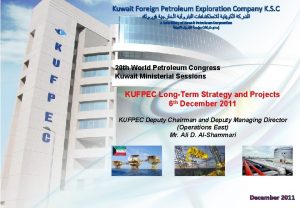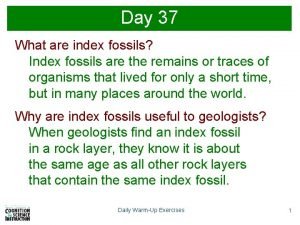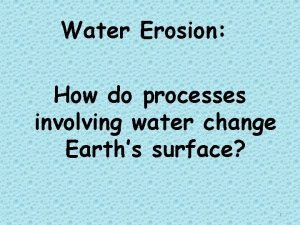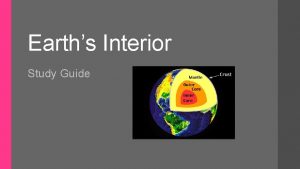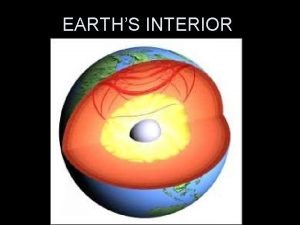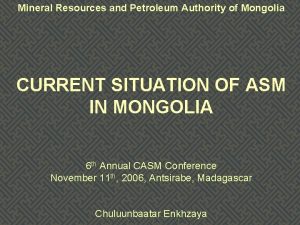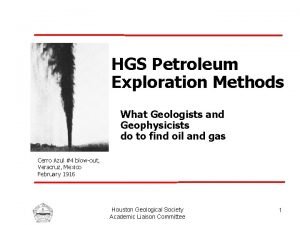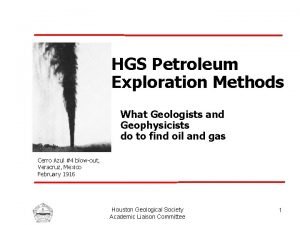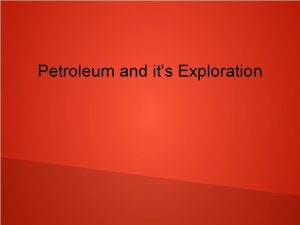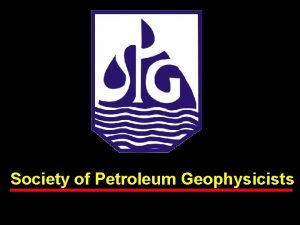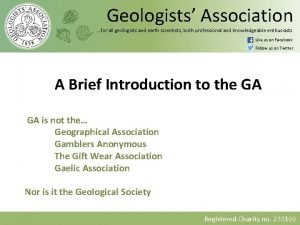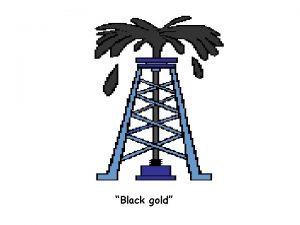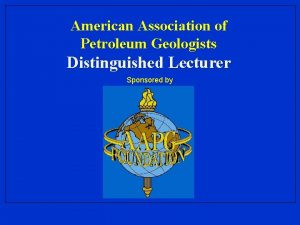HGS Petroleum Exploration Methods What Geologists and Geophysicists













- Slides: 13

HGS Petroleum Exploration Methods What Geologists and Geophysicists do to find oil and gas Cerro Azul #4 blow-out, Veracruz, Mexico February 1916 Houston Geological Society Academic Liaison Committee 1

HGS Petroleum Exploration Methods Part I: What is petroleum and where is it found? Houston Geological Society Academic Liaison Committee 2

What is Petroleum? A natural, yellow-to-black, flammable, liquid hydrocarbon found beneath the earth’s surface Houston Geological Society Academic Liaison Committee 3

The Origin of Petroleum Organic-rich Source Rock Thermally Matured Organic Matter Houston Geological Society Academic Liaison Committee Oil 4

Kerogen Types TOC 2. 12 WT. % TOC. 38 WT. % Houston Geological Society Academic Liaison Committee 5

Types of Petroleum Oil and gas are formed by thermal cracking of organic compounds buried in fine-grained rocks Algae = Hydrogen rich = Oil-prone Wood = Hydrogen poor = Gas-prone Houston Geological Society Academic Liaison Committee 6

What is Petroleum? What is it used for? Houston Geological Society Academic Liaison Committee 7

What is Petroleum? More Than 3, 000 Products • Detergents - Cosmetics • Fertilizers - Weed Killers • Medicine - Antiseptics - Anesthetics • Plastics - Synthetic Fibers • Synthetic Rubber • Rust Preventatives • Liquid Petroleum Gas Houston Geological Society Academic Liaison Committee 8

Petroleum—Where is it found? Basins are containers for sediment Earth’s basins contain sediment/rocks, air, or water Houston Geological Society Academic Liaison Committee 9

Basins: Forces that shape the earth’s crust Plate Tectonics Houston Geological Society Academic Liaison Committee 10

Basins: Forces that shape the earth’s crust Basins form in response to subsidence caused by movement of the crust and grow due tectonic “loading” Houston Geological Society Academic Liaison Committee 11

Basins: Forces that shape the earth’s crust Basins form in response to subsidence of the crust and grow due “loading” of sediment deposited in them Houston Geological Society Academic Liaison Committee 12

Basins: Sedimentary rocks accumulate in basins Basins may contain petroleum source rocks, reservoir rocks and seal rocks Houston Geological Society Academic Liaison Committee 13
 Kuwait foreign petroleum exploration company k.s.c.
Kuwait foreign petroleum exploration company k.s.c. Why are index fossils useful to geologists? *
Why are index fossils useful to geologists? * To study a rock sample geologists observe
To study a rock sample geologists observe Water erosion and deposition
Water erosion and deposition The term geologists use for underground water is
The term geologists use for underground water is How do geologists study direct evidence of earth's interior
How do geologists study direct evidence of earth's interior To study earth's interior geologists often rely on
To study earth's interior geologists often rely on Wax pattern fabrication
Wax pattern fabrication Statoil
Statoil Mineral resources and petroleum authority of mongolia
Mineral resources and petroleum authority of mongolia Petroleum engineering pros and cons
Petroleum engineering pros and cons Pedec logo
Pedec logo Chemical and petroleum solutions
Chemical and petroleum solutions Petroleum and natural gas formation
Petroleum and natural gas formation
